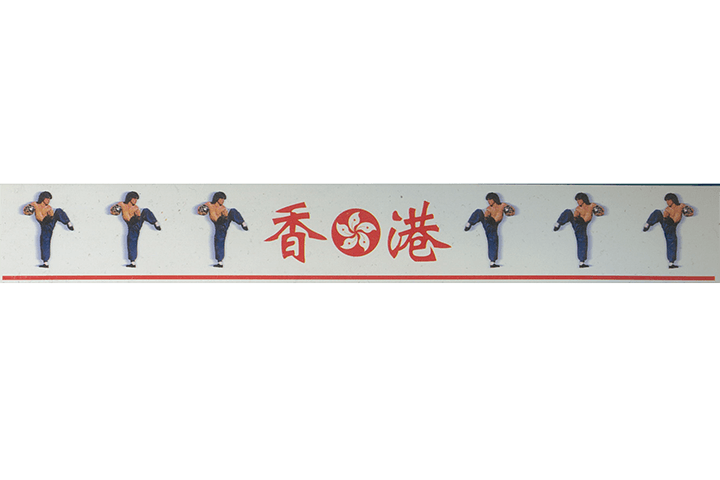【コラム】人の動きを観ること、制御すること、撮ること ー1980年代の子供とジャッキー・チェンの関係から 松谷 容作
2021.2.18 (Thu)
フェスティバルプログラムをより楽しむためのコラムです。このコラムとあわせて、ぜひ楽しんで欲しいおすすめプログラムも紹介しています。(KYOTO EXPERIMENT magazineより転載)
人の動き、所作、身体技法
このコラムを執筆するにあたって、私にあたえられたテーマは人の動きあるいは所作である。こうした動きや所作を、例えばメディア研究者のジョン・ダラム・ピータースなどは、テクニック (技法) と呼ぶ (Peters, 2015)。彼によれば、テクニックとは身体に組み込まれているものであり、そうした身体を道具にして変動的な環境へつぶさに反応し振る舞うこと、また他の存在とコミュニケーションをとることとなる。その意味で、テクニックは、人間あるいは特定の性や年代、民族に限定されず、動物や植物など種々の生命形式が備えているものである。
ピータースによるこのテクニックについての考え方は、アンドレ・ルロワ=グーラン、そしてマルセル・モースの議論を背景としている。なかでもモースは、眠りや走り、水泳、舞踊など様々な身体技法 (その対象の中心は人間であるが) を、年代や民族を軸として細やかに分類している (モース, 1976[1968])。例えば、オーストラリア兵やフランス人の子供はしゃがみ込むことができるが、フランス人の大人はそれができないなど、その分類においてモースは、身体技法は社会性を帯びており、そのため社会や民族、年代の違いは人の動きや所作の違いを生み出すことになると指摘する。
では、人の動きあるいは所作、身体技法は、モースが述べるようにつねに社会性を帯びてしまうのか、一瞬でもそこから脱しうる可能性はないのか。このコラムでは、その問いをジャッキー・チェンの映画と筆者の個人的な経験を通じて考えてみたい。
家庭内存在としてのジャッキー・チェン
ファミコン、週刊少年ジャンプ、ビデオデッキ、ビデオカメラ、FANTAフルーツパンチ。
1976年生まれで1980年代が幼少期にあたる筆者にとって、香港映画のスターであるジャッキー・チェンは、それらと共にいた。そのことは、先立つカンフー映画のスター、ブルース・リーと対照をなす。
ブルース・リーは1970年代のスターであり、1980年代幼少期組にとってはひとつ上の世代のスターであった。そのため1980年代組は、「アチョー! 」という怪鳥音をあげて物真似るテレビタレントや、『北斗の拳』のケンシロウを介して、間接的にそのとてつもない強さとスター性を理解していた。なによりもブルース・リーは、子供の私たちがほとんど足を踏み入れたことのない「ハイソ」な映画館のスターであった。したがって、私たちにとってブルース・リーは、直接触れることができない雲の上の存在であり、実際のところ、FANTAフルーツパンチの味のように、なんだかよく分からないカンフー映画のスターなのである。
対して、ジャッキー・チェンは家のなかにいた。確かに、作品は映画館で上映されていたが、私たちにとってリアルな彼の姿は、テレビの映画番組あるいはレンタルしたビデオテープのなかにあった。ジャッキー・チェンはブラウン管のなかのスターなのである。よって、このスターが披露するコミカルな身体技法は、『8時だヨ! 全員集合』の計算し尽くされたダイナミックなコントシーンや『風雲! たけし城』の破天荒なアクションシーンと横並びにされ、テレビの前に座る1980年代組の子供たちを興奮させていく。さらに言えば、テレビのなかのジャッキー・チェンはいつも同じ声 (声優石丸博也の声) で、自分たちと同じ言葉を話している。軽妙で笑いを誘うその日本語の会話は、私たちとこのスターとの距離をぐっと縮めていく。つまりのところ、ジャッキー・チェンは、1980 年代を生きる子供にとって身近なテレビのスターであり、家庭内の存在であったのだ。
連動と分有
だが、ジャッキー・チェンが出演する作品がテレビで放映される時間は、子供たちにとって就寝時間にあたる。だからこそ、彼の作品は頻繁にビデオ録画 (あるいはレンタルされたビデオテープ) で視聴された。もちろんすべての家庭にビデオデッキがあるわけではない。そのためデッキを所有する友人の家に集まり、複数の子供たちで作品は鑑賞されることになる。そのとき、ビデオのシステムが子供たちに抜群の快楽をもたらす。子供たちはビデオで再生を繰り返すことで、お気に入りのシーンを何度も楽しみ、また早送りや巻き戻し、スローやストップなど、登場人物の動きや所作をコントロールすることで大爆笑に包み込まれる。子供たちにとって、ジャッキー・チェン作品の目玉は物語展開ではなく、なんといってもコミカルな要素を含んだアクションや格闘のシーンであるから、こうした動き・所作の制御は、作品の魅力を倍増させるものとなる。もっと言えば、先立つブルース・リー作品とは異なり、そもそもジャッキー・チェン作品のアクションや格闘のシーンの性格自体が、こうした楽しみ方を誘い込んだのかもしれない。
もはや多くの論者が指摘しているように、武術家であるブルース・リーは、映画におけるアクションや格闘シーンの真正さを、作品の評価を左右する最も重要な要素と捉えていた。そのため、香港映画で慣習的に採用されてきた粤劇 (えつげき) や京劇由来の身体技法 (例えばトランポリンやケーブルなどを用いて飛翔するような幻想的な動きなど) を彼は拒絶し、武術家あるいは武術を学んだ俳優を積極的に起用した。同様に彼は、そうした登場人物をこれまでのようにクローズアップを多用して、あるいは顔を重視して映し出すのではなく、ロングショットやミディアムショットで動く身体をすべて捉え、またそれらのショットを細かに繋ぐのではなく、シークエンス・ショットであるいは必要最低限のモンタージュで提示するのである。つまり、ブルース・リーの映画におけるアクションや格闘のシーンは、生の身体が武術の論理にしたがったかたちでぶつかり合う姿を持続的に映し出すことで成立しているのだ。
対照的にジャッキー・チェンは、京劇を出自とする背景もあってか、アクションや格闘を武術ではなく、動きや所作の表現のひとつとしてみなしているように思える。フランスの詩人であり評論家、ポール・ヴァレリーの言葉を借りるのなら、ジャッキー・チェンのアクションや格闘は「人間の動作の芸術、意志的でありうる動作の芸術」(ヴァレリー, 2006 [1936]: 18. 強調はヴァレリーによるもの) であり、ダンスと言えよう。実際、彼は対置する相手 (たち) を打ち倒すのではなく連動し、ひとつのシーンに含まれるアクションや格闘の動きの総体を単位分数的なやり方で彼 (ら) と分有することで、その場に多彩な踊りをちりばめていく。そしてその分有は、「ハイ! ハイ! 」といった声あるいは服や打撃の音と、声や音に同期する動作の一瞬の停止を通じて、きわめてリズムカルに進められていく。さらに場にある椅子や机、ドアや窓ガラス、床などともジャッキー・チェンは連動・分有し、それら物質のもつ性質 (輝きながら粉々になるガラス、ツルツル滑る床など) を剥き出しにすることで、世界全体を踊らせていくのである。しかし、連動と分有はいつもうまくいくのではない。それは不成立の可能性を孕んでいる。そして、その不成立の瞬間はおかしみの発露となり、ジャッキー・チェンの顔が歪み、その愛らしさが一層増していくのである。
ジャッキー・チェン作品における、こうしたアクションや格闘のシーンが保持する連動と分有、それらの不成立と笑いという性格は、ビデオのリモコンをもった子供たちに動作・所作を制御することでそれらを撹乱するように促してくる。子供たちはまんまとその誘いに乗り、手を叩き抱き合って笑い転げるのだ。
触れれる物真似
しかしだ。笑う子供の手は次第に友人たちへとむかっていく。「ハイ! ハイ! 」と空に拳や足を突き出す子供も出てくる。誰かが言う、「ビデオで撮ってみようや」と。親には絶対に触るなと釘を刺されていた禁断の装置を手にとり、私たちは家の前のいつもの路地裏に急ぐのだ。
すぐさま配役ジャンケンが始まる。当然ジャンケンで負けた子供がジャッキー・チェン役である。理由は簡単だ。敵役は不死身な身体をもち、ジャッキー・チェン役に対して際限なく攻撃を加えることができるからである。ジャッキー・チェン役の子供はその他大勢の敵役の攻撃をずっと受け続けなくてはいけない。別段このことはジャッキー・チェンの映画を改変しているのではない。真なる格闘を目指すブルース・リーの映画のように、死がそこにある、あるいはそれを感じさせるのであれば、事情は違ったかもしれない。だが、ファミコンの適役と同様にジャッキー・チェン映画の敵役は、ヒットポイントの減少はあるかもしれないが、殺害されることなく何度も起き上がって彼に襲いかかっていく。子供たちはそれを正確に物真似るのだ。
また、子供たちは動きや所作も可能な限り正確に物真似ようとする。だが、それは非常に難しい。だから、「ハイ! ハイ! 」といった声と、声に同期する動作の一瞬の停止、それらのリズムの達成だけが目指される。声、動きと停止、リズム、これらを道具立てにして敵役の子供たちは、カメラマンの合図とともに、ジャンケンに負けた後で直ちにランニング姿にさせられたジャッキー・チェン役の子供にむかって襲いかかっていく。ブラウン管のなかで観たジャッキー・チェンの歪んだ顔を目指して。ジャッキー・チェン役の子供は、その顔を見せまいと、何度も襲いかかる友人たちの攻撃をかわし、倒し、反撃を試みる。けれどもブラウン管の模様とは異なり、数の力に圧倒され、最後には子供ジャッキー・チェンは倒されていく。そして、そこでカットがかかるのだ。
「カット」の声とともに、私たちは一目散に家に入っていく。映画のエンディングでジャッキー・チェンが唄う歌をめちゃくちゃな歌詞で大合唱しながら、撮影したばかりの映像をジャッキー・チェンの映画と同様にビデオで再生し、視聴するためである。その映像にはアクションとも格闘とも絶対に言えない、ただただ子供たちがぶつかり合う姿があるのみだが、それでも私たちはいっこうにかまわない。そして、その映像は早送りされ、巻き戻され、ストップされ、スローにされる。私たちは物真似ることで、ジャッキー・チェンの映画に触れ、それになるのだ。そのとき私たちは、不死身な身体を獲得し、動きや所作を操作されるメディアの登場人物となることで、友人たち、路地裏、リビング、テレビなどとの日常的な関係を、社会性を一瞬離脱した、ヴァルター・ベンヤミンが言うところの「遊戯空間」でただただ漂うのである。*1 ただし、ジャッキー・チェンの映画を物真似ることは、その映画が孕むホモソーシャルな関係性やマスキュリニティを知らずに体現することであり、そのジェンダーバイヤスから自由になったとは言えないであろう。*2 その意味では、社会性を一瞬離脱したという感覚や「遊戯空間」という概念は、そのバイヤスのもとで成立していると言えるかもしれない。
ジャッキー・チェン映画の物真似撮影会は、誰かが足を捻る、こけて頭を打つ、ジャッキー・チェン役のランニングシャツの少年が「寒いわ」と不満を言うことなどで終了する。そうしたとき、傷つく、感じる身体が立ち現れ、それに子供たちは興醒めするからだ。なし崩し的に「遊戯空間」が消失する。いつもの日常が再開する。
*1 テレビと子供と遊戯性については長谷正人の議論 (長谷, 2017) から、ベンヤミンの「遊戯空間」と映画の関係については竹峰義和の議論 (竹峰, 2016) から大きな示唆を得た。また、ジャッキー・チェンの映画と「遊戯空間」については、雑賀広海が秀逸な議論を展開している (雑賀, 2019)。
*2 ジャッキー・チェンの映画におけるセクシュアリティやマスキュリニティの問題については、雑賀の議論を参照のこと (雑賀, 2017)。
【参考文献】
雑賀 (広海), 2017:「ハリウッド映画におけるアジア人のアクション・ヒーロー–『燃えよドラゴン』から『バトルクリーク・ブロー』へ」、『ディ
アファネース– – 芸術と思想』第4 号、京都大学大学院人間・環境学研究科岡田温司研究室、95 頁~ 114 頁。
雑賀 (広海), 2019:「落下と反復のスペクタクル– –『プロジェクトA』と『ポリス・ストーリー/ 香港国際警察』における肉体性と形象性」、『映
像学』第101 号、日本映像学会、49 頁~ 68 頁。
竹峰 (義和), 2016『< 救済>のメーディウム– – ベンヤミン、アドルノ、クルーゲ』、東京大学出版会。
長谷 (正人), 2017:『ヴァナキュラー・モダニズムとしての映像文化』、東京大学出版会。
モース (マルセル), 1976[1968]:『社会学と人類学Ⅱ』、有地享、山口俊夫訳、弘文堂。
ヴァレリー (ポール), 2006 [1936]:『ドガ ダンス デッサン』、清水徹訳、筑摩書房。
Peters (John Durham), 2015: The Marvelous Clouds: Towards a Philosophy of Elemental Media, Chicago: University of Press Chicago.
松谷 容作
國學院大學文学部准教授。専門分野は美学・芸術学。19世紀末に萌芽した映像メディアと身体の関係を同時代の諸力学のなかで明らかにすることを研究の出発点としている。映像メディアと身体をめぐる研究に加えて、現在は、生命や環境にかかわる科学や技術、そしてアートを対象とし「人間」以後の感性のあり方も探究の対象としている。
